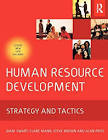|
|

Role of the Trainer |
| Blog | Biography | Business | Children | Computing | Fiction | Cooking | Garden | History | Learning | Psychology | Travel | Erectile Dysfunction |
| BestBooks Home US Bestsellers UK Bestsellers France - Meilleurs Ventes Canada Bestsellers Germany Bestsellers Erectile Dysfunction |
 The ASTD Training and Development Handbook: A Guide to Human Resource Developmentby Robert L. Craig (Editor)The ASTD Training and Development Handbook, Fourth Edition, by Robert L. Craig, is bursting with great new training ideas that'll help you work your magic in your organization. Top industry leaders give 100s of practice-proven techniques you can use right now. More information and prices from: Amazon.com - US dollars SeekBooks.com.au - Australian Dollars Amazon.ca - Canadian dollars Amazon.co.uk - UK pounds Amazon.de - Euros Amazon.fr - Euros
 Human Resource Development: Strategy and Tacticsby Juani Swart, Clare Mann, Steve Brown and Alan PriceThis book examines the factors influencing the effectiveness of an individual's learning, how people learn and the assessment of training and learning needs, showing the significance of aligning departmental, group and individual HRD objectives with business goals. More information and prices from: Amazon.co.uk - British pounds Amazon.com - US dollars SeekBooks.com.au - Australian Dollars Amazon.ca - Cdn dollars Amazon.de - Euros Amazon.fr - Euros  The Accelerated Learning Handbook: A Creative Guide to Designing and Delivering Faster, More Effective Training Programsby Dave MeierAccelerated learning is the use of music, color, emotion, play, and creativity to involve the whole student and enliven the learning experience. The Accelerated Learning Handbook is the first definitive book to explain state-of-the-art accelerated learning techniques to trainers and teachers, and features 40 techniques designed to save money while producing far better results. More information and prices from: Amazon.com - US dollars SeekBooks.com.au - Australian Dollars Amazon.ca - Canadian dollars Amazon.co.uk - British pounds Amazon.de - Euros Amazon.fr - Euros |
The Role of the TrainerHow to BeginIn the ASTD Handbook of Training Design and Delivery (2nd edition, 1999), Nancy Maresh argues that trainers should capitalize on the innate nature of the brain to:
The trainer should aim to: - become proficient at designing and delivering a dynamic curriculum
Maresh argues that "in the process trainers will release learners' intrinsic drive to acquire knowledge, an admirable outcome from any training." People come to learn with a variety of previous experiences, needs and skills, so Maresh advises us to create common ground as a first step in the training process - and every subsequent learning segment. By this she means entering into a dialogue with the members of the training group, acknowledging their experience and speaking directly to "the familiar frustrations, joys, and challenges that link up to the learning task at hand." This is done through a series of questions that highlight the backgrounds of individual members, identify their concerns and gain commitment to the learning process. Maresh suggests 'enrollment' questions beginning with "How many people have ever ..." but not relying on just a show of hands. It is essential to elicit information and comments. Moreover, the trainer should repeat what members have said so that everyone hears and to validate the members who made those statements. For example, a training session on selection interviewing could begin with enrollment questions such as:
Questions such as these should involve everyone in the room and also bring out comments, questions and friendly banter - as well as telling the trainer what level of training will be needed for the group. The common ground acts as a basis for group awareness. When the audience begin to see themselves as a group, they begin to relax and feel comfortable entering into the learning process together. The stage is now set for the trainer to address what Maresh calls the 'big why' in the trainees' minds. Remember that we are building connections and relating to previous experiences. So the purpose, method and intended results of the training need to be explained in relation to the answers given to the enrollment questions. The importance of the subject - especially in relation to trainees' own experience - and what can be done with the learned skills when trainees get back to work should be explored. Then, Maresh advises, the trainer should say something about his or her own background, ideally using a personal story involving the subject of the training session. According to Maresh: "This connects the leader to the participants in an esssential way. People's experiences are dramatic. They include emotions, mystery, tension, climaxes and humor. When personal stories are recounted, learners emotionally identify with the parts that have meaning to them, and this confirms their commitment to participate. Personal stories bond the audience to the instructor, the course content, and other participants." She also addresses the logical component of the adult learner's mind by stressing the need to provide an agenda or list of learning objectives at this point. The team members need to know what the outcomes of the course will be.
Excerpts from Chapter 5, The Trainer's Handbook |
|
|
|
|
|
|
|
|
|
|
|
| Copyright © 2000-2005 Alan Price and BestBooks.biz contributors. All rights reserved. |